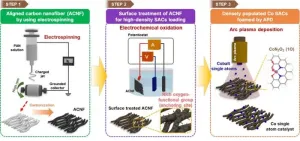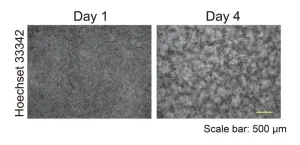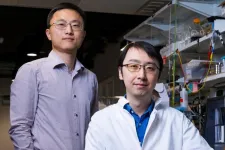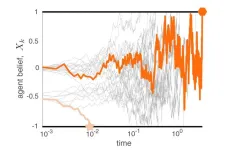(Press-News.org) Planet-warming greenhouse gas emissions associated with the global food supply chains induced by diets could fall by 17% if people change their food choices towards more plant-based diets, a new study reveals.
Researchers believe that a currently over-consuming 56.9% of the global population would save 32.4% of global dietary emissions by changing their diet to the planetary health diet proposed by the EAT-Lancet Commission.
Publishing their findings today (13 Aug) in Nature Climate Change, an international group of researchers note that a diet switch to the planetary health diet would balance the 15.4% increase in global dietary emissions from currently under-consuming populations (43.1% of the global population) moving toward healthier diets.
Within countries, consumer groups with higher expenditures generally cause more dietary emissions due to higher red meat and dairy intake. This study shows that affluent countries consume high-emission diets but display relatively lower levels of inequality, while many poor countries tend to have diets with lower emissions but higher levels of inequality.
Corresponding author, Dr Yuli Shan, from the University of Birmingham, commented: “Compared to plant-based products, animal-based products show greater potential for reducing emissions.
“We should look to reduce over-consumption of emission-intensive products in affluent countries, such as beef in Australia and the US especially for wealthy consumer groups who are overconsuming, which would help to achieve significant health and climate benefits.”
The researchers say that introducing incentives, such as carbon pricing, eco-labeling, and expanding the availability of less emission-intensive products such as vegetarian foods can encourage consumers to make dietary changes.
A well-designed food environment can reshape residents' dietary patterns and parallel development of urban planning and infrastructure can help to reduce the time and financial barriers stopping people from adopting healthier diets.
However, the experts note that in countries such as Mongolia, where diets heavily rely on red meat and dairy products due to a traditional nomadic lifestyle, diet shifts may not be feasible, but there is a need to improve national nutritional education.
Corresponding author, Prof. Klaus Hubacek from the University of Groningen, stated “Low-income countries face greater challenges in reaching healthier diets, with more than 1.5 billion low-income populations worldwide unable to afford the cost of the planetary health diet.
“Diet shifts need increased food consumption, but Sub-Saharan Africa, as well as South and Southeast Asia, have experienced stagnating agriculture production efficiency for decades and cannot produce nor afford to import the required food.
"Agricultural efficiency must increase through various measures such as crop and soil management techniques and introduction of high-yielding crop varieties. But the proportions of nutrient-rich products in food imports must increase – alongside a reduction in restrictive trade policies which tend to raise food prices.”
The researchers note that poor populations often opt for lower-cost, calorie-dense foods with less nutritional benefit. High cost and low affordability remain the largest barriers for these individuals to select healthier diets – meaning that policy efforts must focus on making food more affordable and accessible, especially for lower expenditure groups.
The study evaluates the unequal distribution of dietary emissions (including land-use and beyond-farm emissions) from 140 food products in 139 countries or areas, covering 95% of the global population. It uncovers the extent of inequality of dietary emissions within countries based on detailed expenditure data.
The first author, Yanxian Li, a PhD student at the University of Groningen added “The objective of the diet shift scenario is to assess the potential implications of emission mitigation of the food system resulting from changing consumer choices instead of forcing everyone to adopt the same diet.”
The composition of global food production would need to change considerably to adapt to the substantial changes in demand if the meat-to-plant pathway is to be followed.
Diet shifts would need the global supply (in calorie content) of red meat to decrease by 81%, all sugars by 72%, tubers by 76%, and grains by 50%, while that of legumes and nuts increase by 438%, added fats by 62%, and vegetables and fruits by 28%
Changed food demand could cause fluctuating prices of agricultural products and land in global markets, triggering spillover effects between different food categories or to other non-food sectors – such as stimulating biofuel production - and partly offsetting the benefits of diet shifts.
ENDS
For more information, interviews or an embargoed copy of the research paper, please contact Tony Moran, International Communications Manager, University of Birmingham on +44 (0)782 783 2312 or t.moran@bham.ac.uk. For out-of-hours enquiries, please call +44 (0) 121 414 2772.
Notes to Editors
The University of Birmingham is ranked amongst the world’s top 100 institutions, its work brings people from across the world to Birmingham, including researchers and teachers and more than 8,000 international students from over 150 countries.
Reducing climate change impacts from the global food system through diet shifts - Yanxian Li, Pan He, Yuli Shan, Yu Li, Ye Hang, Shuai Shao, Franco Ruzzenenti, Klaus Hubacek is published by Nature Climate Change.
Participating institutions:
University of Birmingham, UK
University of Groningen, the Netherlands
Cardiff University, UK
Chongqing Technology and Business University, China
East China University of Science and Technology, Shanghai, China
END
Changing food consumers' choices may help cut greenhouse gases
2024-08-13
ELSE PRESS RELEASES FROM THIS DATE:
Significant link found between heme iron, found in red meat and other animal products, and type 2 diabetes risk
2024-08-13
Key points:
Researchers identified a significant link between heme iron—iron found in red meat and other animal products —and risk of type 2 diabetes (T2D), as well as the metabolic pathways underlying the link.
Non-heme iron—iron found in plant-based foods—was not associated with risk of T2D.
The study suggests that cutting down on heme iron from red meat and adopting a plant-rich diet can help lower diabetes risk. And it raises concerns about the addition of heme to increasingly popular plant-based meat alternatives.
Boston, MA—Higher intake ...
Older adults’ life satisfaction varies by immigrant status, living arrangement and social disposition
2024-08-13
TORONTO, ON – Do older adults who live alone feel less satisfied with their lives? A new analysis of about 12,000 respondents aged 65 and older reveals that what matters for Canadian older adults’ life satisfaction is not living alone per se. Rather personality-based social dispositions play a key role in how older adults feel about living alone. In addition, the role these dispositions play tend to differ between Canadian-born and immigrant older adults.
The researchers found that despite the existence ...
Say ‘aah’ and get a diagnosis on the spot: is this the future of health?
2024-08-13
A computer algorithm has achieved a 98% accuracy in predicting different diseases by analysing the colour of the human tongue.
The proposed imaging system developed by Iraqi and Australian researchers can diagnose diabetes, stroke, anaemia, asthma, liver and gallbladder conditions, COVID-19, and a range of vascular and gastrointestinal issues.
Engineering researchers from Middle Technical University (MTU) and the University of South Australia (UniSA) achieved the breakthrough in a series of experiments where they used 5260 images to train machine learning algorithms to detect tongue colour.
Two ...
Rapid removal of emerging endocrine disruptors in wastewater using high-performance single-atom catalysts
2024-08-13
Bisphenols are widely used as the main raw material for plastics such as receipts, water bottles, water containers, and vinyl due to their heat-resistant and mechanochemical properties. Among bisphenols, bisphenol A (BPA) that we often refer to as an "endocrine-disrupting chemicals" has been linked to adverse effects on reproduction, development, intelligence, and various metabolic diseases. Bisphenol F (BPF), a recently developed alternative to BPA Bisphenol A has also been reported in the literature to cause neurological disruption and various health risks.
Dr. Jong Min Kim of the Materials Architecturing ...
Starvation and adhesion drive formation of keratinocyte patterns in skin
2024-08-13
Cell–cell adhesion-induced patterning in keratinocytes can be explained by just starvation and strong adhesion, Hokkaido University researchers find.
Fingerprints are one of the best-recognised examples of pattern formation by epithelial cells. The primary cells in the epithelium are the keratinocytes, and they are known to form patterns at the microscopic and macroscopic levels. While factors affecting this pattern formation have been reported, the exact mechanisms underlying the process are still not fully understood.
A team of researchers, led by Associate ...
Ships now spew less sulfur, but warming has sped up
2024-08-13
RICHLAND, Wash.—Last year marked Earth’s warmest year on record. A new study finds that some of 2023’s record warmth, nearly 20 percent, likely came as a result of reduced sulfur emissions from the shipping industry. Much of this warming concentrated over the northern hemisphere.
The work, led by scientists at the Department of Energy’s Pacific Northwest National Laboratory, published today in the journal Geophysical Research Letters.
Regulations put into effect in 2020 by the International Maritime Organization required a roughly 80 percent reduction in the sulfur content of shipping ...
Rice-built reactor yields green ammonia and purified water
2024-08-13
HOUSTON – (Aug. 12, 2024) – Ammonia plays a critical role in sustaining food production for the world’s growing population, but making it accounts for about 2% of global energy consumption and 1.4% of carbon dioxide emissions. Rice University engineers have developed a revolutionary reactor design that could decarbonize ammonia production while also mitigating water pollution.
In a study published in Nature Catalysis, a team of Rice engineers led by Haotian Wang described the development of a new reactor system that converts nitrates — common pollutants found in industrial wastewater and ...
Think fast — or not: FSU research describes mathematics behind decision making
2024-08-13
New research from a Florida State University professor and colleagues explains the mathematics behind how initial predispositions and additional information affect decision making.
The research team’s findings show that when decision makers quickly come to a conclusion, the decision is more influenced by their initial bias, or a tendency to err on the side of one of the choices presented. If decision makers wait to gather more information, the slower decision will be less biased. The work was published today in Physical Review E.
“The basic result might ...
Largest study of its kind finds common lab tests aren’t reliable for diagnosing Long COVID
2024-08-13
A new study found that most routine laboratory tests are not reliable for diagnosing Long COVID, also known as Post-Acute Sequelae of SARS-CoV-2 infection (PASC).
The study, published today in Annals of Internal Medicine, found no reliable biomarker among 25 routine clinical laboratory values for prior infection, PASC or specific types of PASC clusters. This suggests none of these routine labs can serve as a clinically useful biomarker of PASC.
"Our study shows patients can have severe Long COVID with normal lab results. This ...
Engineers make tunable, shape-changing metamaterial inspired by vintage toys
2024-08-12
Common push puppet toys in the shapes of animals and popular figures can move or collapse with the push of a button at the bottom of the toys’ base. Now, a team of UCLA engineers has created a new class of tunable dynamic material that mimics the inner workings of push puppets, with applications for soft robotics, reconfigurable architectures and space engineering.
Inside a push puppet, there are connecting cords that, when pulled taught, will make the toy stand stiff. But by loosening these cords, the “limbs” of the toy will go limp. Using the same cord tension-based principle that controls a puppet, researchers have developed a new type of metamaterial, a material ...





